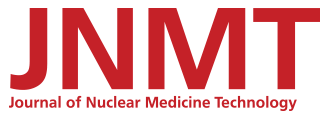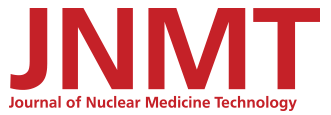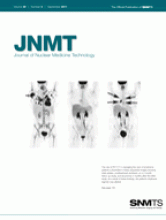Abstract
This article describes the 30-y history of nuclear medicine in Brazil, including reactors, production of radiopharmaceuticals, and trends.
The Comissão Nacional de Energia Nuclear (National Commission for Nuclear Energy), or CNEN, was created in 1956 (decree 40.110 of October 10, 1956) to be responsible for all nuclear activities in Brazil. Later, CNEN was reorganized and its responsibilities were established by law 4118/62, with alterations determined by laws 6189/74 and 7781/89. Thereafter, CNEN became the body in charge of regulating, licensing, and controlling nuclear energy use, and nuclear electric generation was transferred to the energy government sector. CNEN is also responsible for research and development and the production of radioisotopes.
The IEA-R1 (Instituto de Energia Atômica Reator 1), considered the most important Brazilian research reactor, is the oldest in the southern hemisphere. Located at the Instituto de Pesquisas Energéticas e Nucleares (Nuclear and Energetic Research Institute), or IPEN, on the campus of São Paulo University, its construction began in 1956 within the scope of the U.S. program Atoms for Peace. The reactor reached criticality for the first time on September 16, 1957. Although designed to operate at 5 MW, from 1957 until 1961 the operation of the reactor was mainly for commissioning tests and nuclear physics experiments. The reactor was operating on weekdays, less than 8 h a day, with a power level between 200 kW and 2 MW. In 1961, a program was established to produce 131I, and the reactor began to be operated at a constant power of 2 MW, 8 h per day and 5 d per week (1,2). In 1995, a program was established to start the immediate production of 153Sm and to prepare the reactor to produce 99Mo. As result of this decision, the operating schedule was changed to 64 h per week, from Monday through Wednesday, keeping the reactor power at 2 MW. Some modifications were introduced to comply with the new national legislation in order to operate continuously during 120 h per week at 5 MW. The burnup rate, which is currently 240 MW day (MWD), is expected to increase to 1,100 MWD.
The IPR-R1 (Instituto de Pesquisas Radioativas Reator 1), a 250-kW Training Research Isotope General Atomic (TRIGA) reactor operating at the Centro de Desenvolvimento de Tecnologia Nuclear (Nuclear Technology Development Centre), or CDTN, on the campus of the Federal University of Minas Gerais in the city of Belo Horizonte, is used mainly for research. It was the second Brazilian research reactor, with its first criticality reached in November 1960. This reactor operates 4 h per day, 5 d per week, and 40 wk per year. The integrated burnup of the reactor from its first criticality until now has been about 130 MWD (3,4). Because of the low nominal power, except for aging concerns, spent fuel is far from being a problem. The first fuel assembly replacement of the reactor was not expected to occur until 2010.
The third Brazilian research reactor is the Argonauta, located at the Instituto de Engenharia Nuclear (Nuclear Engineering Institute), or IEN, on the campus of the Federal University of Rio de Janeiro. Argonauta's first criticality was reached in February 1965. This reactor can operate at a maximum power of 1 kW during an hour or 500 W continuously. It is usually operated in the range of 170–340 W (5). Its accumulated burnup, since the first criticality, is about 0.25 MWD. As in the case of IPR-R1, because of the low nominal power, storage of spent fuel is not a problem. It is used mainly for training purposes, research, and sample irradiation.
The use of radioisotopes in research occurs mainly at CNEN's research institutes (IPEN, IEN, and CDTN), but also other research centers and universities use radioactive sources. The research is diverse, including nuclear physics, biology, agriculture, health, hydrology, and the environment. Small sources of 3H, 14C, 22Na, 55Fe, 63Ni, 125I, 226Ra, 35S, and 32P are used.
PRODUCTION OF RADIOPHARMACEUTICALS
Radioisotopes for medical uses are produced in IPEN at the Cyclotron Accelerators Center and the Research Reactor Center. These radioisotopes, together with other imported ones, are processed at the Radiopharmacy Center under the requisites of the ISO 9002 standards and distributed just in time to hospitals throughout the country caring for more than 2.3 million patients per year. A total of about 640 TBq of 18F, 67Ga, 123I, 131I, 99Mo, 153Sm, 35S, 32P, and 51Cr compounds are processed annually at IPEN.
Since 1974, IEN has had a CV-28 cyclotron, which was originally used in physics and radioisotope production research and now is used mainly in the production of radiopharmaceuticals for diagnostic examinations. In 1998 the Institute adopted the Karlsruhe Iodine Production System (KIPROS) for the production of 123I (6). This production routine provides conditions for labeling special molecules. The first one was 123I-labeled metaiodobenzylguanidine (MIBG), whose main application is in cardiology.
In 2000, one 18F-FDG production unit from Ion Beam Applications was imported and connected to IEN's CV-28 cyclotron. Use of this unit began on an experimental basis, producing 18F. Samples of FDG labeled with 18F, which was considered the newest and most innovative technology in nuclear medicine (7,8), started to be sent to hospitals in Rio de Janeiro. Because of the short life, only 1.8 h, this radiopharmaceutical must be produced as near as possible to the application site (within ∼200 km).
In 2003, after the installation of the RDS-111 cyclotron (CTI/Siemens), IEN stepped up the production of 18F and, consequently, 18F-FDG. This system is recognized worldwide for its reliability and simplicity of operation. With the RDS-111, IEN was able to produce 18F-FDG in 2 independent ways, with different installations, 1 of them as a backup. The redundancy was created to guarantee the delivery process.
The CDTN inaugurated its radiopharmaceutical production unit in the first half of 2008 (9,10) and started the pilot production of 18F-FDG in the second half of the year, reaching commercial production of this radiopharmaceutical in 2009.
PET Radiopharmaceuticals
PET is a complex and high-cost nuclear medicine technology. The diffusion of PET in Brazil is recent and still limited, but the fall of the federal monopoly on the production of radiopharmaceuticals in 2006 triggered a movement to multiply the number of cyclotron installations and the purchase of PET scanners, especially by the private health sector. The resulting increase in demand has placed pressure on the Brazilian National Health System to incorporate this type of examination into the reimbursement tables, requiring evidence-based updated appraisals to support the decision-making processes.
In the last decade, 18F-FDG has become a breakthrough in nuclear medicine (9). Associated with new-generation equipment for PET or SPECT, 18F-FDG is now widely used in oncology, visualizing and distinguishing malignant from benign tumors as well as distinguishing primary tumors from metastases. In cardiology, one of its applications is assessing the level of damage to the heart that has undergone a cardiovascular accident. In neurology, PET technology can be applied to diagnose Parkinson, Alzheimer, and Tourette diseases and to visualize brain damage caused by drug consumption. PET technology began in 1981, when the first PET scanner became available. Currently, there are more than 500 centers operating mainly in the United States, Europe, and Japan. In the specific case of Brazil, the tropical diseases are an open field for research, with unpublished applications.
123I-MIBG Radiopharmaceutical
MIBG is labeled at the IEN radiopharmacy laboratory using ultrapure 123I produced at the KIPROS system. The 123I is obtained by bombardment of a 124Xe target with a 24-MeV, 20-μA proton beam in the CV-28 cyclotron. The labeling method is based on a nucleophilic substitution in an MIBG molecule. In order for the product to be used as a diagnostic agent, the radiochemical purity must be as high as 97%. Because of a half-life of only 13.2 h, 123I-MIBG allows the diagnosis of heart diseases and tumors. However, 131I-MIBG, because of a longer half-life (8 d), is more suitable for higher-dose treatment of tumors. With the production of ultrapure 123I, IEN follows a worldwide trend to make short-half-life radioisotopes available for examinations and therapy.
DATA AND TRENDS
In terms of sales, Brazil is a major player in the radiopharmaceutical market despite considerable barriers to production and reimbursement. In 2009, Brazil sold almost 70 million Reais of 18F-FDG. Converting this value to U.S. dollars, sales of 18F-FDG in Brazil were approximately $35 million, compared with U.S. sales of $522 million in 2009. Despite having only 2 PET radiopharmaceutical facilities, Brazilian production was equal to 6.7% of the U.S. production from more than 30 PET facilities. This is an impressive feat. However, it is not clear that these facilities can continue to expand production to meet the growing demand for imaging using radiopharmaceuticals. The reliance on just 2 high-volume facilities for the entire national production of PET radiopharmaceuticals suggests an urgent need to increase the number of production facilities in Brazil.
Acknowledgments
This study was supported by FAPERJ and CNPq. No potential conflict of interest relevant to this article was reported.
Footnotes
Published online Jul. 27, 2011.
- Received for publication February 7, 2011.
- Accepted for publication March 29, 2011.







